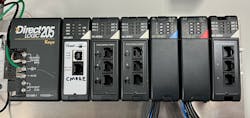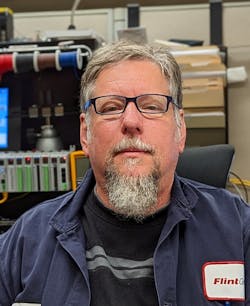The PLC has progressed greatly since the early days of small instruction sets and the limitations of only having discrete input and output. Modern controllers have much more processing power and can handle discrete I/O, as well as analog, temperature, motion control and many other forms of input or output. Instruction sets have grown to include analog scaling functions, math functions, proportional–integral–derivative (PID) control and much more.
One of the functions that has grown through the years is the ability to handle data. This data has been in various serial forms such as Modbus remote terminal unit (RTU), but industry has been quickly shifting to Ethernet protocols and the advantages they bring to communication. Serial busses are still widely in use in the installed machinery base and still available in device offerings.
The example we will look at is somewhat novel, in that most of the processing is done using serial data with a small amount of discrete I/O. It is also an interesting system because it uses a central processing unit (CPU) that is based on a very neat concept for an upgrade path. Analysis of this device was performed to determine the most effective and safest method of providing site security, whether in the form of modifying this existing system or purchasing a replacement system developed by security professionals. The decision was made for replacement.
With that in mind, let us take a minute to examine the hardware. The chassis is a DirectLogic DL205. This chassis originally would house a DL250 CPU from the DirectLogic line available from AutomationDirect. This combination has been a very popular offering and has a very large installed base. This particular chassis contains the H2-DM1 CPU, which is built on the Do-more platform and was released in 2012. This CPU was designed as a direct replacement for the DL250 and installs into the DL205 chassis. It has four times more program memory, has nine times more data memory and runs up to 20 times faster than its predecessor. It provides an entirely different platform that programs with Do-more Designer software instead of DirectSoft. It has an expanded instruction set and features that make it a much more versatile and powerful programming platform. It also offers convenience and cost savings by supporting all the same base units and modules as the DL250 CPU.
The chassis also includes three H2-Serio modules, each of which has three RS-232 serial ports. There is an additional serial port available on the CPU, bringing the total available number of serial ports to 10 (Figure 1). In addition, the chassis contains one discrete input and one discrete output module, each having eight points at 24 Vdc.
This system was designed to control entry to a manufacturing facility. Serial inputs were fed from four different radio-frequency identification (RFID) readers. The discrete outputs would lock or unlock turnstiles or an entry gate. Each employee had a badge with a unique RFID chip. The badge would be scanned, and, if the person’s name was found within the database, it would open the appropriate entrance or exit. There was also a system included wherein security personnel could read a new employee’s badge on a desktop reader and enter that into the database. In addition, a serial port was used for communication with a desktop PC for data logging. All of these together made up the six serial inputs on two of the PLC modules.
The serial connection on the CPU card was reserved for communication with the HMI, which was a 7-inch C-More panel. This touchscreen panel provided information on the person who was currently scanning in or out. It also displayed system status, errors and a shift register for the previous five employee scans.
The data handling in the software is controlled with Streamin and Streamout commands. Data from each reader is read directly as a string and stored in a designated memory address. It is then converted to an integer and moved into a reserved memory location for the lookup function. This is a convenient method to retrieve data and bypasses Modbus registry access. The stream commands were continuously monitoring, with the input blocked only during an initiated stream from the other readers to avoid data crashes.
The system was in use for many years and was ultimately replaced by a more robust offering from a security company. It served its purpose well and is an interesting look at a system that provided control based mainly on serial data streams.
Larry Stepniak is electrical engineer at Flint Group. Contact him at [email protected].
About the Author

Larry Stepniak
Flint Group
Larry Stepniak is electrical engineer at Flint Group. Contact him at [email protected].

Leaders relevant to this article:

